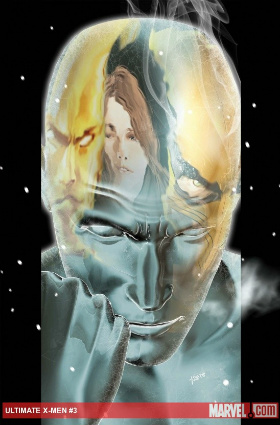Comics /
Comic Reviews /
Marvel Comics
Ultimate Comics: X-Men #3
By Zak Edwards
November 21, 2011 - 12:02
The latest issue of Nick Spencer’s Ultimate Comics: X-Men proves just exactly why monthly titles are problematic and enjoyable all at once. While the first issue of Ultimate Comics: X-Men was mostly about ideas and the second was about the execution of these ideas, this issue deals with these ideas in the contexts of back-rooms, the necessities of status quo, and their maintenance and adaptation. Every issue so far is trying to take a different and multifaceted approach to Spencer’s interpretation of the basic argument of the X-Men comic: how does a minority or persecuted group continue to exist, both in terms of the established majority and the minority itself. It’s the heart of the Prof. Xavier/ Magneto dynamic, the former attempts a romanticized and optimistic integration manifesto, the other a more violent, active, and reactionary approach. The popular cultural equivalent of Martin Luther King Jr. and Malcolm X is generally thought of as the real life equivalent, although that comparison requires a notable ignorance of what Malcolm X wrote himself and relies on popular media imaging. So while Ultimate Comics: X-Men may just simply be continuing the basic metaphors with a different sort of face, the story works very well, if encountering only a few problems along the way.
 |
Ultimate Comics: X-Men is mostly taking advantage of a monthly serial, keeping individual issues cohesive in their approach while remaining thematically articulate and comprehensive on a larger scale. For this, Spencer spends the entire issue either in back rooms and underground, making the setting both literal and importantly metaphorical. Mutants, the ever-ready minority, exists as a manufactured enemy amongst the people simultaneously everywhere and nowhere. As a result, the reactions of the general public permeate the issue, even if the public themselves are shown very little. Only a double spread shows the riots, but they are a extremely important for all the characters. They represent an underlying problem of equality and the image of the true citizen, as well as general dissatisfaction. I appreciate Spencer’s approach this issue much more than last and conceptually the book is unfolding nicely. Unfortunately, it might also be one of his sloppier scripts in terms of dialogue. Given the other Nick Spencer book released this week, Morning Glories, has a great ear for how people talk and interact, this issue is quite awkward in places, especially with the discussion between Quicksilver, the son of Magneto, and government employee Valerie Cooper. Rather than relying on tone, Spencer simply uses Valerie to point out how and why the characters are acting the way they are. At one point, Spencer has Valerie blatantly tell the reader Pietro is using “veiled threats and smug condescension” rather than relying on his abilities as a writer to simply show rather than tell. Pietro doesn’t fare much better; a scene that is quite conceptually brilliant gets distracted by hammering phrases leaving little faith in the audience. The villain, William Stryker, also remains fairly one-dimensional, something that is compounded in a book being so obviously multifaceted. So while the book continues to excite and entertain while approaching core thematic issues in interesting ways, there are elements and stylistic choices that simplify something that should be getting complicated.
Paco Medina’s art sort of follows in this vein as well. Points of the story are actually quite amazing to look at, his energy and style serve the title well in scenes like the prison escape flashbacks. The paneling and scenarios are also dynamic and engaging, keeping things moving between Spencer’s musings, but Medina is still and inconsistent and problematic artist. His characters are strangely posed, impossibly so for the female characters, and their appearances can switch ages noticeably from page to page. Two pages in particularly, focusing on Quicksilver, change in quality so much, it’s simply awful to look at because of the gross inconsistency between panels. There are instances where characters’ faces change as well, looking nothing like themselves if not for their costumes. Unfortunately, this book could be wonderfully rendered by so many talented artists out there, but Medina' work detracts from the whole experience.
Grade: B Things need to improve in some respects, but the book is still great.
Last Updated: January 17, 2025 - 08:20
